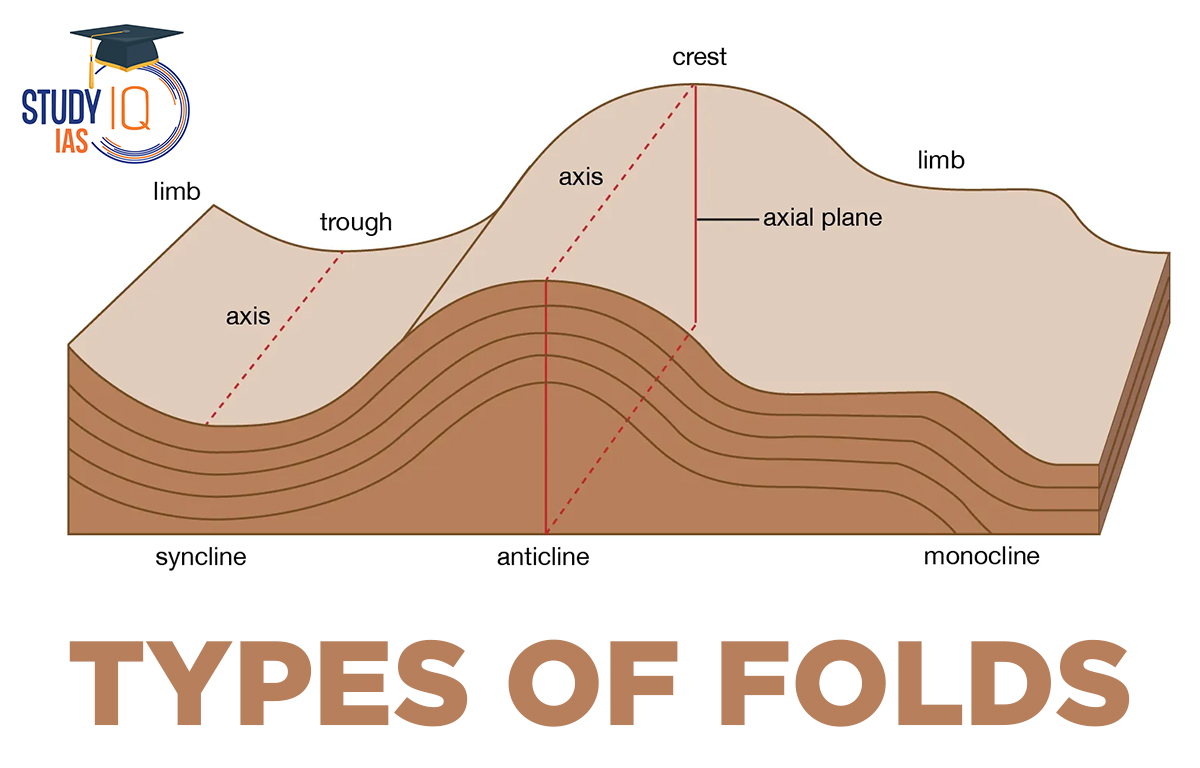Table of Contents
Types of Folds
A fold is a wavy shape made when rocks in the Earth’s crust bend under pressure. These folds are made of different layers of rock. The wavy shapes that curve up are called anticlines. In an anticline, the oldest rock layers are in the middle, and the younger layers spread outwards. Synclines are folds that curve downwards. In a syncline, the younger rock layers are in the middle, while the older layers spread outwards. Fold mountains are created when two or more tectonic plates push against each other. This is why these mountains, which are made of sedimentary rocks, are often found near the edges of continents.
When the plates collide, the rocks are pushed together and folded into hills and mountains. These mountains form at areas where plates meet, called compression zones. Most fold mountains are located at or near the boundaries of continental plates.
Read More: Geomorphic Processes
Folds Meaning
When the Earth’s plates move together, they push on the crystal rocks. This pressure makes the rocks bend and create wavy shapes called folds.
Parts of a Folds
The following are the parts of the fold:
| Anticline | An anticline is the unfolded rock strata that take up an arch’s shape. |
| Syncline | The downfolded rock strata, which looks like a trough, is called a syncline. |
| Limbs | The two sides of the fold are called limbs. |
| Axial Plane | The plane that bisects the angle between two limbs is called the axial plane. |
| Axis | The line of intersection of the axial plane with the upper or lower surface of any rock bed is called the axis. |
| Strike | The strike of an inclined bed is the direction of any horizontal line on the bedding plane. |
| Dip | The inclination of the rock beds with respect to the horizontal plane is called dip. |
Read More: Plate Tectonics Theory
Types of Folds
The Types of folds formed depends on various factors such as the nature of the rock, the intensity of the compressional force, etc. Different folds have been recognized based on structure, appearance, and geometry. They are as follows:
1. Symmetrical
These are folds where the axial plane is vertical and both limbs incline uniformly. They are formed when compressive forces regularly act with moderate intensity.
2. Asymmetrical Folds
They are folds where the axial plane is inclined and the limbs of the anticline dip in opposite directions. One limb is longer with a moderate inclination, while the other is shorter with a steep inclination.
Read More: Sea Floor Spreading Theory
3. Overturned Fold
It is a type of fold where the axial plane is inclined and both limbs dip in the same direction but at different angles.
4. Isoclinal Folds
These are folds where two limbs dip at equal angles in the same direction. They are formed when the compressional forces are so strong that the limbs become parallel.
5. Recumbent Fold
Recumbent folds are characterised by a horizontal axial plane. They are formed when compressive forces are so strong that the limbs become parallel and horizontal. Such recumbent folds are widely found in the Alps.
Read More: Continental Drift Theory
6. Chevron
These are folds with sharp and angular crests and troughs.
7. Fan Fold
When the limbs of a fold are overturned to such an extent that it looks like a fan, it is called a fan fold.
8. Open Fold
Folds, where the angle between two limbs is usually greater than 90 degrees but less than 180 degrees, are called open folds. The rock beds have the same thickness throughout the fold in such folds. They are formed due to moderate compressional force.
9. Closed Fold
Folds, where the angle between two limbs is less than 90 degrees, are called closed folds. The rock beds are thinner at the limbs and thicker at the crests and troughs. They are formed by intensive compressional force.
Read More: Physiography of India
10. Nappe
These folds result from complex folding mechanisms due to intense horizontal movement and high compressional forces. They are formed from recumbent folds. The crest of recumbent folds is weak and has cracks. When there is further intense compressional force, one limb of the fold slides forward and overrides the other. Such features are called Nappes. Several nappies are found in the Alps mountains.
11. Anticlinorium
An anticlinorium is formed when there is a series of minor anticlines and synclines within one extensive anticline.
12. Synclinorium
A synclinorium is formed when there is a series of minor anticlines and synclines within one extensive syncline.
Read More: Big Bang Theory
Fold Mountains
Fold mountains form when two or more of the Earth’s tectonic plates push against each other. That is why they are often found near the edges of continents. The pressure from this collision causes rocks to bend and fold into hills and mountains.
These mountains form at places where plates meet, called compression zones. In these areas, the rocks near the edges of the continent are usually weaker and more likely to fold.
Most fold mountains are made of sedimentary and metamorphic rocks that form under high pressure and low temperatures. They develop when there are soft minerals, like salt, below the surface.
Fold mountains are created when layers in the upper part of the Earth’s crust bend and fold. These mountains can be either old or young. Examples of old fold mountains include the Appalachians in North America, the Ural Mountains in Russia, and the Aravali range in India. The Himalayas and the Alps are examples of young fold mountains.
Read More: Important Mountain Passes in India
Types of Folds UPSC
A uniform framework for comprehending mountain-building processes, volcanic eruptions, earthquakes, the evolution of the Earth’s surface, and reconstructing the planet’s former continents and oceans was provided by the plate tectonics theory, which deals with the dynamics of the lithosphere, the outer shell of the planet. A UPSC aspirant should be well aware of the topic of how various changes happen inside and over the surface of the earth. The details in the article would help candidates prepare for UPSC 2023.


 Story of Meera Bai and Her Devotion For ...
Story of Meera Bai and Her Devotion For ...
 Desert Climate, Distribution, Climatic C...
Desert Climate, Distribution, Climatic C...
 Deserts of India Map, Features of Thar D...
Deserts of India Map, Features of Thar D...





















